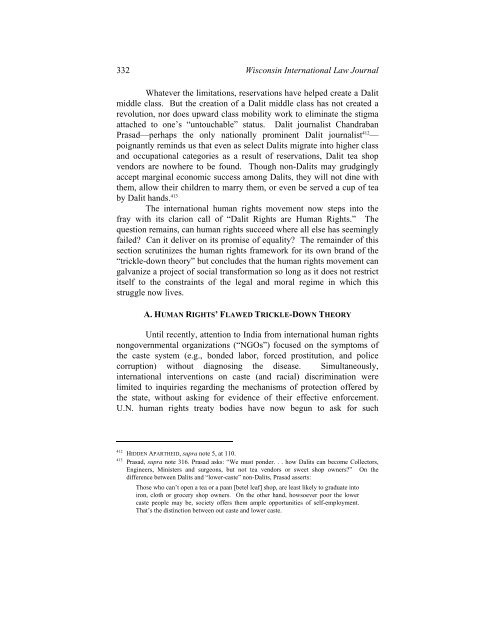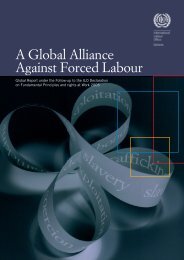332 Wisconsin <strong>International</strong> Law JournalWhatever the limitations, reservations have helped create a <strong>Dalit</strong>middle class. But the creation of a <strong>Dalit</strong> middle class has not created arevolution, nor does upward class mobility work to eliminate the stigmaattached to one’s “untouchable” status. <strong>Dalit</strong> journalist ChandrabanPrasad—perhaps the only nationally prominent <strong>Dalit</strong> journalist 412 —poignantly reminds us that even as select <strong>Dalit</strong>s migrate into higher classand occupational categories as a result of reservations, <strong>Dalit</strong> tea shopvendors are nowhere to be found. Though non-<strong>Dalit</strong>s may grudginglyaccept marginal economic success among <strong>Dalit</strong>s, they will not dine withthem, allow their children to marry them, or even be served a cup of tea<strong>by</strong> <strong>Dalit</strong> hands. 413The international human rights movement now steps into thefray with its clarion call of “<strong>Dalit</strong> Rights are Human Rights.” Thequestion remains, can human rights succeed where all else has seeminglyfailed? Can it deliver on its promise of <strong>equal</strong>ity? The remainder of thissection scrutinizes the human rights framework for its own brand of the“trickle-down theory” but concludes that the human rights movement cangalvanize a project of social transformation so long as it does not restrictitself to the constraints of the legal and moral regime in which thisstruggle now lives.A. HUMAN RIGHTS’ FLAWED TRICKLE-DOWN THEORYUntil recently, attention to India from international human rightsnongovernmental organizations (“NGOs”) focused on the symptoms ofthe <strong>caste</strong> system (e.g., bonded labor, forced prostitution, and policecorruption) without diagnosing the disease. Simultaneously,international interventions on <strong>caste</strong> (and racial) discrimination werelimited to inquiries regarding the mechanisms of protection offered <strong>by</strong>the state, without asking for evidence of their effective enforcement.U.N. human rights treaty bodies have now begun to ask for such412 HIDDEN APARTHEID, supra note 5, at 110.413 Prasad, supra note 316. Prasad asks: “We must ponder. . . how <strong>Dalit</strong>s can become Collectors,Engineers, Ministers and surgeons, but not tea vendors or sweet shop owners?” On thedifference between <strong>Dalit</strong>s and “lower-<strong>caste</strong>” non-<strong>Dalit</strong>s, Prasad asserts:Those who can’t open a tea or a paan [betel leaf] shop, are least likely to graduate intoiron, cloth or grocery shop owners. On the other hand, howsoever poor the lower<strong>caste</strong> people may be, society offers them ample opportunities of self-employment.That’s the distinction between out <strong>caste</strong> and lower <strong>caste</strong>.
Vol. 26, No. 2 Equal <strong>by</strong> Law, Un<strong>equal</strong> <strong>by</strong> Caste 333evidence while domestic agencies have invested greater energy intoexposing gaps in protection. 414For the human rights movement, what began as a failure ofdiagnosis has now transmuted into a failure of strategy. Theinternational human rights framework holds as its organizing principlethe promotion of a system of <strong>law</strong>s, universal in their application, butdelivered <strong>by</strong> the state. Inherent to this strategy is an over-reliance on thestate as a neutral agent of social change and the assumption that likeeconomic growth, international <strong>law</strong>s and admonitions directed to thehigher echelons of the state will trickle down to the rest of thepopulation. The primacy the human rights movement has given to thesystem of <strong>law</strong>s and the state’s implementation of these <strong>law</strong>s merits closerscrutiny, most especially in the context of the <strong>caste</strong> system. The socialand religious sanction, when combined with the economic incentives, allbut ensures that the practice of “untouchability” is perpetuated. In turn,attempts to alter the status quo are met with violent recrimination.Where then does that leave the <strong>law</strong> and the state?1. THE ROLE OF THE LAW AND THE STATEThe introductory paragraph to Narendra Jadhav’s familybiography, Untouchables: My Family’s Triumphant Escape from India’sCaste System, proclaims:Every sixth human being in the world today is an Indian, and everysixth Indian is an erstwhile untouchable, a <strong>Dalit</strong>. Today, there are165 million <strong>Dalit</strong>s (<strong>equal</strong> to more than half the population of theUnited States) and they continue to suffer under India’s 3,500 yearold<strong>caste</strong> system, which remains a stigma on humanity. However,<strong>Dalit</strong>s are awakening. We are struggling against <strong>caste</strong> discrimination,illiteracy, and poverty; our weapons are education, selfempowerment,and democracy. 415The opening of the book exposes the magnitude of abuses perpetrated inthe name of upholding the <strong>caste</strong> system, and the monumental challengefacing a democracy only sixty years young to dismantle and reconstructsociety away from practices that are almost sixty times as old asindependent India itself. Of note in the above quote is not just themagnitude and age of oppression, but that in the abbreviated list of414 See, e.g., HIDDEN APARTHEID, supra note 5; NHRC REPORT, supra note 110.415 NARENDRA JADHAV, UNTOUCHABLES: MY FAMILY’S TRIUMPHANT JOURNEY OUT OF THE CASTESYSTEM IN MODERN INDIA 1 (2005).
- Page 1 and 2:
EQUAL BY LAW, UNEQUAL BY CASTE: THE
- Page 3 and 4:
Vol. 26, No. 2 Equal by Law, Unequa
- Page 5 and 6:
Vol. 26, No. 2 Equal by Law, Unequa
- Page 7 and 8:
Vol. 26, No. 2 Equal by Law, Unequa
- Page 9 and 10:
Vol. 26, No. 2 Equal by Law, Unequa
- Page 11 and 12:
Vol. 26, No. 2 Equal by Law, Unequa
- Page 13 and 14:
Vol. 26, No. 2 Equal by Law, Unequa
- Page 15 and 16:
Vol. 26, No. 2 Equal by Law, Unequa
- Page 17 and 18:
Vol. 26, No. 2 Equal by Law, Unequa
- Page 19 and 20:
Vol. 26, No. 2 Equal by Law, Unequa
- Page 21 and 22:
Vol. 26, No. 2 Equal by Law, Unequa
- Page 23 and 24:
Vol. 26, No. 2 Equal by Law, Unequa
- Page 25 and 26:
Vol. 26, No. 2 Equal by Law, Unequa
- Page 27 and 28: Vol. 26, No. 2 Equal by Law, Unequa
- Page 29 and 30: Vol. 26, No. 2 Equal by Law, Unequa
- Page 31 and 32: Vol. 26, No. 2 Equal by Law, Unequa
- Page 33 and 34: Vol. 26, No. 2 Equal by Law, Unequa
- Page 35 and 36: Vol. 26, No. 2 Equal by Law, Unequa
- Page 37 and 38: Vol. 26, No. 2 Equal by Law, Unequa
- Page 39 and 40: Vol. 26, No. 2 Equal by Law, Unequa
- Page 41 and 42: Vol. 26, No. 2 Equal by Law, Unequa
- Page 43 and 44: Vol. 26, No. 2 Equal by Law, Unequa
- Page 45 and 46: Vol. 26, No. 2 Equal by Law, Unequa
- Page 47 and 48: Vol. 26, No. 2 Equal by Law, Unequa
- Page 49 and 50: Vol. 26, No. 2 Equal by Law, Unequa
- Page 51 and 52: Vol. 26, No. 2 Equal by Law, Unequa
- Page 53 and 54: Vol. 26, No. 2 Equal by Law, Unequa
- Page 55: Vol. 26, No. 2 Equal by Law, Unequa
- Page 58 and 59: 312 Wisconsin International Law Jou
- Page 60 and 61: 314 Wisconsin International Law Jou
- Page 62 and 63: 316 Wisconsin International Law Jou
- Page 64 and 65: 318 Wisconsin International Law Jou
- Page 66 and 67: 320 Wisconsin International Law Jou
- Page 68 and 69: 322 Wisconsin International Law Jou
- Page 70 and 71: 324 Wisconsin International Law Jou
- Page 72 and 73: 326 Wisconsin International Law Jou
- Page 74 and 75: 328 Wisconsin International Law Jou
- Page 76 and 77: 330 Wisconsin International Law Jou
- Page 80 and 81: 334 Wisconsin International Law Jou
- Page 82 and 83: 336 Wisconsin International Law Jou
- Page 84 and 85: 338 Wisconsin International Law Jou
- Page 86 and 87: 340 Wisconsin International Law Jou
- Page 88 and 89: 342 Wisconsin International Law Jou
















